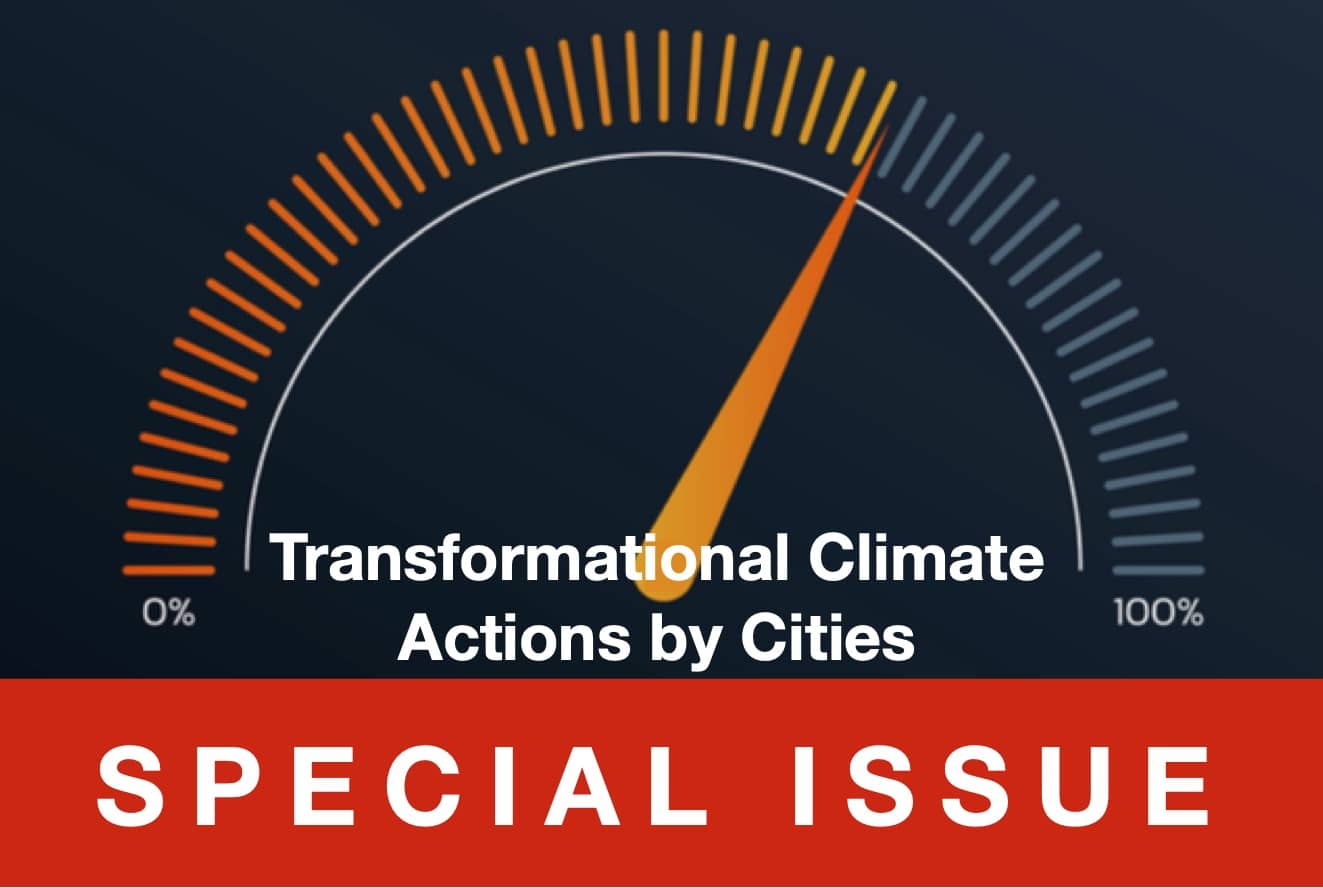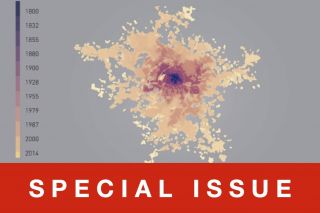
www.buildingsandcities.org/journal-content/special-issues/transformational-climate-actions-cities.html
Transformational Climate Actions by Cities

This special issue advances understandings of the nature, extent and effectiveness of cities' implementation efforts to realise low-carbon, climate resilient cities.
Papers in this special issue expose ambitious
actions that some municipalities are taking: visioning, target-setting, and
planning (undertaken with community engagement), climate-friendly regulations
(for the built environment and urban infrastructure particularly), innovations
in finance and capital mobilization to fund climate adaptation, novel
institutional configurations, and partnership arrangements with civil society
actors. Despite these progressive steps, these
papers reveal that an implementation gap remains.
Guest Editors: John B. Robinson and Kim R. Slater
Based on the case studies presented, the nature of this gap in large part stems from capacity and jurisdictional limitations, rather than a dearth of ambition or willingness to advance bold moves per se. Multiple insights emerge from the papers in this special issue regarding how local governments might begin to close the gap and meet the climate challenge.
A predominant theme in the papers is a need for more effective, multiway, climate governance. Vertically, there is a need for more coordinated efforts between levels of government, with higher levels of government enabling cities. Horizontally, there is a need for more coordinated/less siloed multi-departmental, multi-sectoral, multi-jurisdictional approaches.
In examining climate governance, this
collection of papers shows how social practice and transitions theories afford
complementary analytical approaches. Ultimately, they suggest both differing
and overlapping intervention points from social practice-informed
recommendations for normalizing climate action to multilevel perspective-informed suggestions for improved
niche-regime-landscape configurations and communication that accelerate
multisectoral climate action.
Meaningful public engagement, particularly by way of co-production processes, is also valuable for fostering social learning. Several papers highlight this can occur through multiple avenues such as experiments, pilots, demonstration projects, or living labs that involve residents and other community stakeholders helping to innovate climate interventions. It is vital that local governments ensure their regulations are flexible enough to accommodate and take up learning born of local experiments and living labs. The facilitation of collaborative visioning can help move local governments along the adaptation spiral, while prompting social learning among planners and policymakers.
Table of contents
Transformational climate actions by cities (Editorial)
K.R. Slater & J.B. Robinson
Institutionalisation of urban climate adaptation: three municipal experiences in Spain
M. Olazabal & V. Castán Broto
Stretching or conforming? Financing urban climate change adaptation in Copenhagen
S. Whittaker & K. Jespersen
Integrating climate change and urban regeneration: success stories from Seoul
J. Song & B. Müller
Transformational climate action at the city scale: comparative South-North perspectives
D. Simon, R. Bellinson & W. Smit
Assessing climate action progress of the City of Toronto
K.R. Slater, J. Ventura, J.B. Robinson, C. Fernandez, S. Dutfield & L. King
Climate action in urban mobility: personal and political transformations
G. Hochachka, K. G. Logan,
J. Raymond & W. Mérida
Canadian cities: climate change action and plans
Y. Herbert, A. Dale & C.
Stashok
Meeting GHG reduction goals with waste diversion: multi-residential buildings
V. MacLaren, E. Ikiz &
E. Alfred
Latest Peer-Reviewed Journal Content
Acceptability of sufficiency consumption policies by Finnish households
E Nuorivaara & S Ahvenharju
Key factors for revitalising heritage buildings through adaptive reuse
É Savoie, J P Sapinski & A-M Laroche
Cooler streets for a cycleable city: assessing policy alignment
C Tang & J Bush
Understanding the embodied carbon credentials of modern methods of construction
R O'Hegarty, A McCarthy, J O'Hagan, T Thanapornpakornsin, S Raffoul & O Kinnane
The changing typology of urban apartment buildings in Aurinkolahti
S Meriläinen & A Tervo
Embodied climate impacts in urban development: a neighbourhood case study
S Sjökvist, N Francart, M Balouktsi & H Birgisdottir
Environmental effects of urban wind energy harvesting: a review
I Tsionas, M laguno-Munitxa & A Stephan
Office environment and employee differences by company health management certification
S Arata, M Sugiuchi, T Ikaga, Y Shiraishi, T Hayashi, S Ando & S Kawakubo
Spatiotemporal evaluation of embodied carbon in urban residential development
I Talvitie, A Amiri & S Junnila
Energy sufficiency in buildings and cities: current research, future directions [editorial]
M Sahakian, T Fawcett & S Darby
Sufficiency, consumption patterns and limits: a survey of French households
J Bouillet & C Grandclément
Health inequalities and indoor environments: research challenges and priorities [editorial]
M Ucci & A Mavrogianni
Operationalising energy sufficiency for low-carbon built environments in urbanising India
A B Lall & G Sethi
Promoting practices of sufficiency: reprogramming resource-intensive material arrangements
T H Christensen, L K Aagaard, A K Juvik, C Samson & K Gram-Hanssen
Culture change in the UK construction industry: an anthropological perspective
I Tellam
Are people willing to share living space? Household preferences in Finland
E Ruokamo, E Kylkilahti, M Lettenmeier & A Toppinen
Towards urban LCA: examining densification alternatives for a residential neighbourhood
M Moisio, E Salmio, T Kaasalainen, S Huuhka, A Räsänen, J Lahdensivu, M Leppänen & P Kuula
A population-level framework to estimate unequal exposure to indoor heat and air pollution
R Cole, C H Simpson, L Ferguson, P Symonds, J Taylor, C Heaviside, P Murage, H L Macintyre, S Hajat, A Mavrogianni & M Davies
Finnish glazed balconies: residents' experience, wellbeing and use
L Jegard, R Castaño-Rosa, S Kilpeläinen & S Pelsmakers
Modelling Nigerian residential dwellings: bottom-up approach and scenario analysis
C C Nwagwu, S Akin & E G Hertwich
Mapping municipal land policies: applications of flexible zoning for densification
V Götze, J-D Gerber & M Jehling
Energy sufficiency and recognition justice: a study of household consumption
A Guilbert
Linking housing, socio-demographic, environmental and mental health data at scale
P Symonds, C H Simpson, G Petrou, L Ferguson, A Mavrogianni & M Davies
Measuring health inequities due to housing characteristics
K Govertsen & M Kane
Provide or prevent? Exploring sufficiency imaginaries within Danish systems of provision
L K Aagaard & T H Christensen
Imagining sufficiency through collective changes as satisfiers
O Moynat & M Sahakian
US urban land-use reform: a strategy for energy sufficiency
Z M Subin, J Lombardi, R Muralidharan, J Korn, J Malik, T Pullen, M Wei & T Hong
Mapping supply chains for energy retrofit
F Wade & Y Han
Operationalising building-related energy sufficiency measures in SMEs
I Fouiteh, J D Cabrera Santelices, A Susini & M K Patel
Promoting neighbourhood sharing: infrastructures of convenience and community
A Huber, H Heinrichs & M Jaeger-Erben
New insights into thermal comfort sufficiency in dwellings
G van Moeseke, D de Grave, A Anciaux, J Sobczak & G Wallenborn
'Rightsize': a housing design game for spatial and energy sufficiency
P Graham, P Nourian, E Warwick & M Gath-Morad
Implementing housing policies for a sufficient lifestyle
M Bagheri, L Roth, L Siebke, C Rohde & H-J Linke
The jobs of climate adaptation
T Denham, L Rickards & O Ajulo
Structural barriers to sufficiency: the contribution of research on elites
M Koch, K Emilsson, J Lee & H Johansson
Disrupting the imaginaries of urban action to deliver just adaptation [editorial]
V Castán-Broto, M Olazabal & G Ziervogel
Nature for resilience reconfigured: global- to-local translation of frames in Africa
K Rochell, H Bulkeley & H Runhaar
How hegemonic discourses of sustainability influence urban climate action
V Castán Broto, L Westman & P Huang
Fabric first: is it still the right approach?
N Eyre, T Fawcett, M Topouzi, G Killip, T Oreszczyn, K Jenkinson & J Rosenow
Social value of the built environment [editorial]
F Samuel & K Watson
Understanding demolition [editorial]
S Huuhka
Data politics in the built environment [editorial]
A Karvonen & T Hargreaves



Latest Commentaries
Decolonising Cities: The Role of Street Naming
During colonialisation, street names were drawn from historical and societal contexts of the colonisers. Street nomenclature deployed by colonial administrators has a role in legitimising historical narratives and decentring local languages, cultures and heritage. Buyana Kareem examines street renaming as an important element of decolonisation.
Integrating Nature into Cities
Increasing vegetation and green and blue spaces in cities can support both climate change mitigation and adaptation goals, while also enhancing biodiversity and ecological health. Maibritt Pedersen Zari (Auckland University of Technology) explains why nature-based solutions (NbS) must be a vital part of urban planning and design.